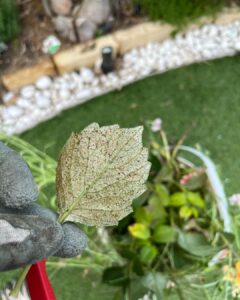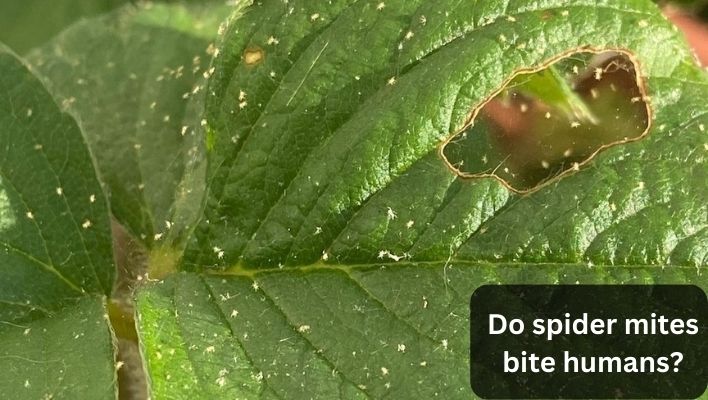Did you know that tiny creatures called spider mites can wreak havoc on plants and crops? While they may be small in size, their presence can have significant consequences. But here’s the burning question on everyone’s mind: do spider mites bite humans?
In this article, we will uncover the truth behind this mystery and provide you with all the essential information you need to know about spider mites and their potential impact on human health.
If you’ve ever come across spider mites in your garden or noticed them on your houseplants, you might have wondered if they pose a threat to you or your loved ones. We understand the concern, and that’s why we’re here to shed light on the topic.
Throughout this article, we’ll address common misconceptions, discuss spider mite behavior, and explore the truth about their interactions with humans.
Below, we’ll explore what spider mites are, their feeding habits, why they primarily target plants, and whether or not they can harm humans. We’ll also delve into identifying spider mite infestations, preventing their spread, and providing guidance on what to do if you suspect an infestation.
By the end of this article, you’ll have a clear understanding of the risks (or lack thereof) that spider mites pose to humans and how to protect yourself and your plants from their presence.
Understanding Spider Mites
Spider mites may be tiny, but their impact on plants and crops can be substantial. Let’s take a closer look at these minuscule arachnids to understand their appearance, habits, and favored habitats.
Spider mites belong to the Tetranychidae family and are closely related to spiders and ticks. They measure only about 0.5 millimeters in length, making them barely visible to the naked eye. These pests are most commonly found in warm and dry environments, thriving in conditions where humidity is low.
One of the most distinctive features of spider mites is their ability to produce silk webbing. This webbing creates a protective environment for the mites, shielding them from predators and adverse weather conditions. When you observe fine webbing on your plants, it’s often a sign of a spider mite infestation.
Spider mites have a rapid reproductive cycle, allowing their populations to explode under favorable conditions. In warm weather, a single mite can reach maturity in as little as a week, laying up to 100 eggs during its lifespan.
When it comes to their feeding habits, spider mites are primarily known for their preference for plants. They extract sap from plant tissues using their piercing-sucking mouthparts, causing damage to the leaves.
The damage manifests as stippling, yellowing, and eventually, the withering of leaves. Spider mites are opportunistic feeders, meaning they will attack a wide variety of plants, including vegetables, fruits, ornamentals, and even crops.
Now that we better understand spider mite behavior and their preference for plants, let’s address the burning question: do spider mites bite humans?
Spider Mites’ Feeding Behavior
Now that we know spider mites primarily target plants, let’s delve deeper into their feeding behavior and address the misconception surrounding spider mite bites on humans.
The primary source of nutrition for spider mites is the sap found within the leaves of plants. They pierce plant cells using their specialized mouthparts, known as stylets, and extract the sap contained within.
As they feed, they leave behind tiny punctures on the leaves, which can eventually lead to significant damage if left untreated. The extraction of sap weakens plants, affecting their overall health and vitality.
It’s crucial to clarify that spider mites are not known to bite humans. While they may accidentally come into contact with human skin, they lack the physical adaptations required to feed on humans.
Their mouthparts are specifically designed for piercing and extracting sap from plant tissues, not for piercing human skin.
Understandably, people may confuse the effects of other common insect bites, such as mosquitoes or bed bugs, with spider mite bites. However, it’s essential to differentiate between these bites for accurate identification and appropriate treatment.
Spider mite bites on plants result in stippling, yellowing, and withering of leaves, while bites from insects that feed on humans often lead to localized redness, itching, and swelling.
So, if you notice signs of spider mite infestations, focus on protecting your greenery, and implementing effective pest control measures.
Spider Mite Behavior around Humans
Spider mites only have an affinity for plants and crops, making them their primary targets. They find an abundance of food in the form of plant sap, which sustains their growth and reproduction.
Their small size and ability to reproduce rapidly allow them to infest plants quickly, causing significant damage if left unchecked.
While spider mites primarily focus on plants, there are instances where they may come into accidental contact with humans. Here are a few reasons why this might occur:
- Disruption of Infested Plants: When plants infested with spider mites are disturbed, either through pruning, shaking, or even brushing against them, the mites can be dislodged and inadvertently come into contact with human skin.
- Outdoor Activities: If you engage in outdoor activities like gardening or working in areas where spider mite infestations are present, there is a possibility of accidental contact. However, it’s important to note that such contact is typically brief and doesn’t result in intentional biting or prolonged exposure.
- Transferring Mites: Spider mites can hitch a ride on clothing, tools, or other objects, potentially leading to their transfer from infested plants to human skin. However, they do not actively seek out humans as hosts.

It’s worth mentioning that situations can arise where people mistake other conditions for spider mite bites. For example:
- Allergic Reactions: Some individuals may have allergic reactions to certain plants, including their pollen or other substances present on the plants. These reactions can cause skin irritations that might be mistaken for spider mite bites.
- Contact Dermatitis: Contact with certain plants, chemicals, or other environmental factors can trigger contact dermatitis, resulting in skin inflammation, redness, or itching. This condition is not caused by spider mite bites.
- Other Insect Bites: Various insects, such as mosquitoes, fleas, or bed bugs, can bite humans and cause skin reactions. It’s important to differentiate between spider mite bites and bites from other insects to ensure appropriate treatment.
If you experience skin irritations or suspect insect bites, it’s advisable to consult a healthcare professional for proper diagnosis and guidance. They can help determine the cause of the symptoms and recommend suitable treatments.
Remember, while spider mites may occasionally come into contact with humans, their primary focus remains on plants. By understanding their behavior and the situations where contacts may occur, you can better address any concerns and focus on effective pest management techniques for your plants and crops.

Can Spider Mites Bite Humans?
No, spider mites do not bite humans. It’s a common misconception that needs to be debunked. Spider mites lack the physical attributes and behavior to bite humans. Let’s explore why this is the case.
Spider mites have specialized mouthparts known as stylets, which are adapted for piercing and sucking plant tissues. These stylets are designed to extract sap from the cells of plants, allowing the mites to feed and obtain their nourishment. However, these mouthparts are not suited for biting human skin.
The structure and size of spider mites’ mouthparts are specifically tailored to penetrate plant tissues and access the sap reservoirs within.
They are delicate and fine, allowing the mites to navigate through the microscopic openings of plant cells. This adaptation is essential for their survival and reproduction, as they depend on the nutrients obtained from plant sap.
In contrast, human skin is a much tougher barrier compared to plant tissues. Spider mites do not possess the mandibles or other biting structures necessary to break through human skin. Their mouthparts are simply not designed to penetrate or bite humans.
While spider mites may accidentally come into contact with human skin, either through disruption of infested plants or other means, they do not intentionally bite or feed on humans. Any skin reactions or irritations experienced after such contact are not a result of spider mite bites.
It’s important to be aware of this fact and avoid attributing skin issues to spider mite bites without proper evidence. If you encounter skin reactions or suspect insect bites, it’s recommended to consult a healthcare professional for an accurate diagnosis and appropriate treatment.
By understanding that spider mites do not bite humans, you can focus on implementing effective pest control measures to protect your plants and maintain a healthy environment. Remember, spider mites pose minimal risk to human health, and their primary impact is on plant vitality.
Prevention and Treatment of Spider Mites
Preventing spider mite infestations is key to maintaining healthy plants and minimizing the risk of any associated human reactions. Here are some practical tips to help prevent infestations:
- Regular Plant Inspection: Regularly inspect your plants, both indoors and outdoors, for any signs of spider mite infestations. Look for stippling, yellowing leaves, fine webbing, or clusters of tiny moving dots, which indicate the presence of mites. Early detection allows for prompt action.
- Maintain a Clean Environment: Keep your gardening tools, pots, and plant containers clean and free from debris. Remove fallen leaves or other organic matter from the vicinity of your plants, as they can provide hiding places for spider mites.
- Practice Good Plant Care: Healthy plants are less susceptible to spider mite infestations. Ensure proper watering, as both drought-stressed and overwatered plants are more prone to attacks. Provide adequate sunlight and proper air circulation to promote plant vigor.
- Monitor Humidity Levels: Spider mites thrive in dry environments with low humidity. Increase humidity levels around your plants by misting them regularly or using a humidifier, as this can deter spider mites from establishing infestations.

 If you discover a spider mite infestation, prompt treatment is essential. Here are some options for treating spider mite infestations:
If you discover a spider mite infestation, prompt treatment is essential. Here are some options for treating spider mite infestations:
- Organic Insecticides: Consider using organic insecticidal soaps or oils specifically formulated to target spider mites. These products work by suffocating or disrupting the pests, providing effective control while minimizing harm to beneficial insects and the environment.
- Chemical Insecticides: Chemical insecticides can be used as a last resort if organic options are ineffective or the infestation is severe. Choose insecticides labeled for spider mites and follow the instructions carefully, taking necessary precautions to protect yourself and the environment.
- Natural Predators: Introduce beneficial insects, such as predatory mites, ladybugs, or lacewings, which feed on spider mites. These natural predators can help control the population and provide long-term management of infestations. Research the appropriate species for your specific region and plant type.
- Pruning and Quarantine: If the infestation is limited to specific parts of a plant, prune and dispose of the affected areas to prevent further spread. Consider quarantining infested plants to prevent the mites from spreading to other healthy plants.
Always follow the recommended guidelines and safety precautions when using any treatments or insecticides. It’s also important to note that prevention is often more effective than treatment, so regularly monitoring your plants and implementing preventive measures can save you time and effort in the long run.
By practicing good plant care, early detection, and appropriate treatment methods, you can effectively manage spider mite infestations and maintain a healthy environment for your plants and yourself.
Do Spider Mites Bite Humans FAQs
Can spider mites live on or in the human body?
No, spider mites cannot live on or in the human body. Spider mites are specialized pests that primarily infest plants and feed on plant sap.
They cannot establish a sustained presence on human bodies. While they may accidentally come into contact with humans, they cannot survive or reproduce on human skin.
Are there any reported cases of spider mite bites on humans?
No, there are no reported cases of spider mite bites on humans. Spider mites do not bite humans as they lack the necessary physical adaptations to do so.
Their mouthparts are specifically designed for piercing and extracting sap from plant tissues, not for biting human skin.
Any skin reactions or irritations that may occur after contact with spider mites are typically due to other factors, such as direct contact with the mites or their waste products.
How can I differentiate between spider mite bites and other insect bites?
It can be challenging to differentiate between spider mite bites and other insect bites solely based on the appearance of the bites. However, there are some general differences to consider:
- Appearance: Spider mite bites on plants often result in stippling, yellowing, and withering of leaves. In contrast, bites from insects that feed on humans, such as mosquitoes or bed bugs, typically manifest as localized redness, itching, swelling, or even raised bumps.
- Patterns and Clusters: Spider mite bites on plants tend to occur in clusters, appearing as tiny dots or specks close together on the affected leaves. Insect bites on humans may have a more scattered pattern depending on the insect and individual reactions.
- Symptoms and Timing: Spider mite bites on plants typically take time to manifest visible symptoms, with signs of damage appearing gradually over time. In contrast, insect bites on humans often result in immediate skin reactions, such as itching or swelling, shortly after the bite occurs.
If you suspect you have been bitten and are experiencing skin reactions or irritations, it is important to consider other possible causes, such as allergic reactions, contact dermatitis, or even unrelated insect bites.
Consulting a healthcare professional can help provide a proper diagnosis and guidance on appropriate treatment based on your specific situation.
Conclusion
Spider mites do not bite humans. While they are notorious pests that cause damage to plants by feeding on their sap, they lack the physical attributes and behavior to bite or feed on human skin. Spider mites have specialized mouthparts adapted for piercing and sucking plant tissues, not for biting humans.
It’s important to debunk the misconception that spider mites bite humans, as it can lead to unnecessary concerns and misunderstandings.
Although spider mites may occasionally come into contact with humans, such contact is typically accidental and does not involve intentional biting or prolonged exposure.
Human reactions to spider mites are usually a result of direct contact with the mites or their waste products. These reactions can include skin irritation, redness, itching, and, in some cases, allergic reactions.
It’s crucial to differentiate these reactions from actual spider mite bites and consider other possible causes of skin irritations or bites, such as other insects or allergens.
Prevention is key to managing spider mite infestations. Regular plant inspections, maintaining a clean environment, and practicing good plant care can help prevent infestations from occurring. If an infestation does occur, treatment options include organic or chemical insecticides and the introduction of natural predators.
By understanding the behavior of spider mites, recognizing the differences between spider mite bites and other insect bites, and implementing effective prevention and treatment methods, you can maintain healthy plants and minimize the risk of any associated human reactions.
